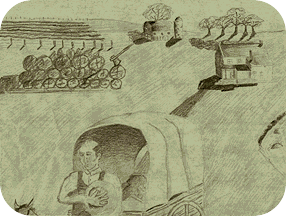Heritage Gateways
Official Sesquicentennial K-12 Education Projectsponsored by the Utah State Board of Education, the BYU-Public School Partnership and the Utah Education Network
General Information
Previous | Next1846: Leaving Nauvoo

Image courtesy of: Heritage Gateway Project Images, These images have been gathered to support the Sesquicentennial celebration of the immigration to Utah.
Apostle John Taylor, in an address to the Saints in Great Britain (15 Nov 1846) stated that the Mormon exodus from Nauvoo involved moving "(as near as we could estimate) about 15,000 Saints, 3,000 wagons, and 30,000 hed of cattle ...a great number of horses and mules ...[and] an immense number of sheep."
The approximately 1,300-mile-long Great Trek must be divided into two parts: The nearly 265-mile-long section across Iowa in 1846 and the 1,032 (as measured by Clayton in 1847) -mile-long segment across the Great Plains of Nebraska and Wyoming into Utah in 1847. The Iowa portion of the trail was used relatively little, mainly by the Mormons fleeing Illinois in 1846, and by some other Mormons jumping off from Keokuk, Iowa, in 1853. It was also used in 1856-1857 by seven companies of Mormon Handcarters from Iowa City who intersected the 1846 Mormon Trail at what is now Lewis, Cass County. (See "The Handcart Emigrants.") Thousands of other Mormons also crossed Iowa up to as late as 1863 on variants of the 1846 trail and on completely different trails, but all these trails intersected the trail of 1846 somewhere in western Iowa.
Across the monotonous, rolling Central Lowlands of Iowa, the trail of 1846 generally followed primitive territorial roads as far as Bloomfield, Davis County, then vague Potawatomi (the name exists in different spellings) Indian and trading trails along ridges from one water source to another and to an Indian agent's settlement on the Missouri River at what is now Council Bluffs. The trail always fell within 50 miles of the present Missouri state line. There is very little of the old trail left in Iowa. Time and the plow have erased almost all remains.
The Iowa portion of the trek was the worst. In spite of long preparations for quitting Nauvoo, the Mormons were not at all well prepared when they left during February and March of 1846. For one thing they left earlier than was necessary or had been planned. The year 1846 began badly. The charters of the Nauvoo Legion and of the City of Nauvoo were revoked in January, thus curtailing what legal and military protection the Mormons had. Rumors were spreading that the U.S. Government would prevent the Mormons from leaving because they were suspected of counterfeiting and that federal troops from St. Louis were planning to march on Nauvoo? Apparently these rumors led church leaders to decide to begin the evacuation of Nauvoo as soon as possible, rather than to await the agreed-upon spring departure time. In the beginning the weather was terrible, and the vanguard of Saints, a mixed group of men, women, and children, were inexperienced as well as unprepared. It took a month to cover the first 100 miles--an average of only 3 miles per day.
On February 4, 1846, the first wagons, belonging to a Charles Shumway, pulled out of Nauvoo, crossed the Mississippi River on ferries near the present Exodus to Greatness marker. After crossing the Mississippi the pioneers traveled west some 7 miles to a staging ground at Sugar Creek, Lee County, to await the arrival of Brigham Young and other church leaders who joined them February 15th.
The initial crossing and camping were neither orderly nor disciplined, and few people had followed advice regarding adequate food supplies. In addition to this suggested "outfit," which cost about $250, the pioneers needed all the clothing, bedding, and other foodstuffs they could acquire. For example, although Heber C. Kimball, an apostle, reached Sugar Creek with a two-year supply of food, the mismanagement and unpreparedness of others caused his store to be consumed within two weeks.
In spite of this and other difficulties attending the evacuation, months of planning and preparation made the exodus, even though several months ahead of schedule, more orderly and successful than is generally believed, and far from the tragic route of folklore.
Because of the weather, general unpreparedness, and lack of experience in moving large groups of people (except for Zion's Camp of 1834), the crossing of Iowa in 1846 was much more difficult than the migration west of the Missouri in 1847. While many deaths were recorded at Winter Quarters and beyond, the journals of the first group to cross Iowa list only 9 deaths, 5 of which were children's. Even if some were not recorded, it is unlikely that many more than nine people died in the first group. The skills they learned while crossing Iowa in 1846 made the much longer part of the trek from the Missouri River to the Valley of the Great Salt Lake in 1847 easier. Through this part of the journey, the pioneers also set the pattern for settling the Great Basin.
Source: Historic Resource Study - Mormon Pioneer National By Stanley B. Kimball, Ph.D., May 1991. (The study focuses on the history of the trail from its official beginning in Nauvoo, Illinois, to its terminus in Salt Lake City, Utah, during the period 1846-1869. During that time, thousands of Mormon emigrants used many trails and trail variants to reach Utah. This study emphasizes the 'Pioneer Route' or 'Brigham Young Route' of 1846-1847. The sections on Mormon beliefs and motivations for going west have been omitted. Interested persons can find ample sources for that information. The footnotes, bibliography, maps, pictures, pioneer companies by name and dates for the 22-year period, and historic sites - about 2/3 of the book - have also been left out for space considerations. Thanks to Dr. Kimball and the National Park Service for the availability of this information.)